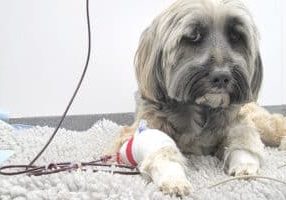
Hypothyroidism is a common endocrine disease in dogs. The most common causes are lymphocytic thyroiditis or idiopathic thyroid atrophy. Although diagnosis can be straightforward in some patients it can be more challenging in others.
What is the signalment and most common clinical signs?
Typically middle-aged to older dogs are affected. The onset of clinical signs is gradual and includes lethargy, weight gain, cold intolerance, dermatological concerns (e.g. alopecia), and neuromuscular disease (e.g. vestibular signs, facial nerve paralysis). Laryngeal paralysis and megaoesophagus can occur in association with hypothyroidism, but a causal relationship has not been established.
What blood work changes are typical of hypothyroidism?
The most common clinicopathological findings are anaemia and hyperlipidaemia. The expected endocrine changes are low total and free T4 with concurrent increased TSH. It is important to note that total T4 and free T4 can be lowered in several other circumstances:
- Nonthyroidal illness can suppress total T4 and more severe illness will also suppress free T4. Therefore a patient should be retested once recovered from the concurrent illness.
- Breed related variations are recognised, with the normal reference range for total and free T4 being lower in sighthounds.
- Increased circulating glucocorticoids in dogs with hyperadrenocorticism, or dogs treated with exogenous glucocorticoids, often lowers total and free T4. TSH should be normal in these dogs.
- Other drugs that can lower serum thyroid hormones include phenobarbitone and sulphonamides (TSH may increase as a compensatory response to these drugs) and clomipramine (TSH is unaffected).
- Total and free T4 can be spuriously increased or decreased by the presence of T4 autoantibodies (which can occur in dogs with lymphocytic thyroiditis).
The importance of measuring concurrent TSH and how to interpret
Due to the many factors that can affect T4, it is important to measure TSH concurrently. However results can occasionally be challenging to interpret:
- TSH can be within the reference range in 20-40% of dogs with hypothyroidism. The reason for this is that as time progresses, there is a loss of the TSH response to a persistently low T4 (i.e. we may have missed the previous rise in TSH).
- You may find a normal T4 with an increased TSH. This could reflect either (1) recovery from recent non-thyroidal illness, or (2) an early subclinical stage of the disease whereby increased TSH is successfully maintaining normal T4 levels. These dogs should be monitored and perhaps retested 1-3 months later.
Is there an additional benefit in looking for thyroglobulin autoantibodies (TGAA)?
Histologically there are two forms of primary hypothyroidism recognised in dogs; lymphocytic thyroiditis and idiopathic atrophy (the latter may be an end point of the former). During the inflammatory phase of lymphocytic thyroiditis, antibodies are released into the circulation. Most laboratories measure TGAA (as a reflection of the concurrent presence of T3 or T4 autoantibodies). However TGAA are only detectable in 50% of hypothyroid dogs. If TGAA is positive, it implies the presence of thyroiditis but provides no information on thyroid gland function and therefore is not diagnostic for clinical hypothyroidism.
When to start treatment?
A diagnosis is established when you have appropriate clinical signs, clinicopathological findings and endocrine test results. Unfortunately discordant endocrine test results can occur and in those situations the clinical signs, clinicopathological findings and clinician index of suspicion need to be considered before deciding whether to retest in 3-6 months or embark on trial treatment.
How to treat and monitor?
The treatment of choice is levothyroxine. Twice daily treatment is recommended to improve the likelihood of a positive response, especially important in a therapeutic trial. Once stable, some dogs can be transitioned onto a once daily regime. Absorption of the drug may be affected by food. Clinical response should be evaluated by measuring T4 and TSH 4-6 hours post administration of levothyroxine, 6-8 weeks after starting treatment.
Case Advice or Arranging a Referral
If you are a veterinary professional and would like to discuss a case with one of our team, or require pre-referral advice about a patient, please call 01883 741449. Alternatively, to refer a case, please use the online referral form
About The Discipline
Internal Medicine

Need case advice or have any questions?
If you have any questions or would like advice on a case please call our dedicated vet line on 01883 741449 and ask to speak to one of our Internal Medicine team.
Advice is freely available, even if the case cannot be referred.
Internal Medicine Team
Our Internal Medicine Team offer a caring, multi-disciplinary approach to all medical and surgical conditions.